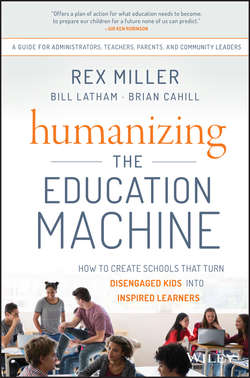Читать книгу Humanizing the Education Machine - Cahill Brian - Страница 14
На сайте Литреса книга снята с продажи.
CHAPTER 1
NUMBERS DON'T LIE
How One Family Escaped the Great Machine
ОглавлениеIt may help you to know the short story of one family who lived through the crumbling of the K–12 system and saw the seeding of new possibilities. That family is mine.
Back in the 1990s we moved to one of the best school districts in the state, not because we were snobs, but because we cared. We wanted our three kids to have fine educational experiences, rolling right through K–12. All three of them are, well, exceptional. By that I mean that they are true individuals. Everyone who knows them would agree. They did not come from an assembly line or central casting. Lisa and I did not know it at the time, but in looking back, we can see that our kids were like canaries in the coal mines. Their experiences (and those of thousands of other students) exposed the toxins in K–12 education.
This book is for those who do not have the time or resources to sift through the many books or conferences or websites in order to gather the knowledge essential to taking action.. those who are not willing to wait for local, regional, or national regulations to trickle down or be parachuted in.
And, I admit that our three children carried some surprising baggage.
Part of what makes Emily, our 24-year-old bold and beautiful daughter, so exceptional is Asperger syndrome. Her challenges have always caused this lovely and brilliant woman to express very unique social skills, perspectives, and boundaries.
I describe our second child, Daniel, as “a merry prankster.” He, the opposite of Emily when it came to social skills and boundaries, did extremely well in elementary school. But later he began to exhibit some discomfort with school rules and expectations. He was eventually diagnosed with ADHD.
Right out of the chute, our third child, Caleb, loved school. But very quickly (and for a whole different set of reasons) he, too, began disengaging in middle school. He started coming home and giving Lisa a hard time.
We realized that we were not dealing with an organization of rational, knowledgeable, and empathetic teachers and administrators; we were coping with a machine.
With all three of our children, we increasingly realized that we were not dealing with an organization of rational, knowledgeable, and empathetic teachers and administrators; we were coping with a machine. For a while, we tried to work with the Machine. We tried to change its speed, update its “software,” find a sense of compassion somewhere within its steel-toothed gears, help our kids to adapt to the Machine, help the Machine to adapt to them.. but in the long run, there we were, caught between our love for our children and our ingrained respect for the education process.
In all three cases the Machine just kept moving our, and many other, students down the conveyor belt, delaying decisions, ordering tests, and pushing them into ill-fitting boxes. No one seemed to care. For example, none of Emily's teachers had training for working with students with Asperger's, or even had a working knowledge of the syndrome. Some of them did not believe she had it. After all, she had an outgoing personality and “looked normal.”
One of Daniel's teachers did not believe in ADHD. As that teacher chewed gum and gazed out at us from his “bunker” (beneath his U.S. Marines buzz cut and over his folded arms), you could see that he had already diagnosed Daniel. He could see clearly that Daniel was a skateboarder and he knew that was “trouble in River City.” In fact, he once said (while Daniel was in the room), “Kids who skateboard are always trouble.”
